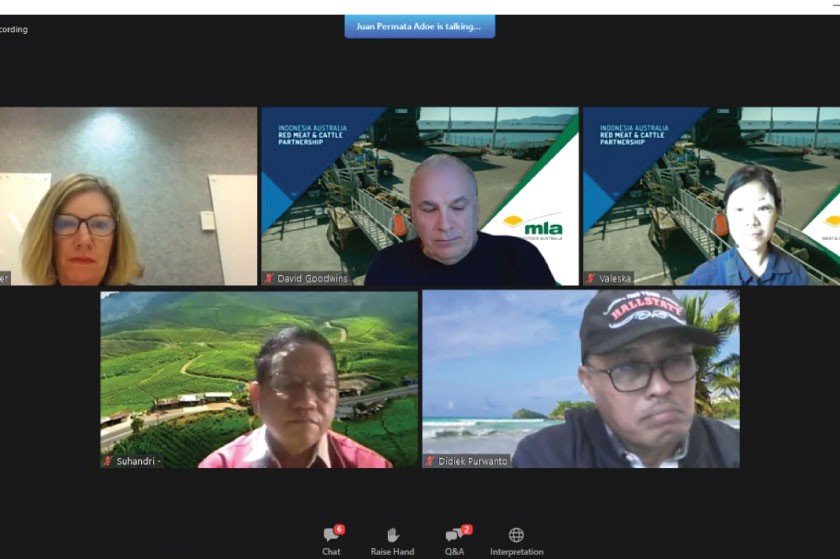MLA – Partnership 2nd Webinar : Opportunities presented by IA-CEPA for the Indonesia - Australia Red Meat Trade
The second MLA/Partnership Webinar on the Indonesia – Australia red meat and cattle trade was held on the 5th of June, with approximately 100 industry participants attending. The webinar focussed on beef consumption and demand over Eid ul Fitr in the midst of COVID-19 and new growth opportunities emerging out of IA-CEPA, that will come into force on 5th July 2020.
David Goodwins, the Partnerships evaluation specialist, provided an update on the Indonesian feedlot and beef sector. Compared to the same time last year, the industry reported a drop of around 10-20% in beef sales, and a drop in live feeder cattle imports from Australia by about 25%, until end May. The price of fresh beef was relatively stable at Rp120,000 per kg, increasing to Rp130,000 in the lead-up to Eid ul Fitr.
In 2020, 500,000 live feeder cattle imports are expected, which is well down on the 676,000 head imported in 2019. Most feedlots plan to limit importation until they can more clearly read the market, with many postponing imports until the 5% tariff on feeder cattle imports is removed in early July when IA-CEPA comes into force.
Didiek Purwanto, Chairman of the Indonesian Feedlot Association (GAPUSPINDO) and Suhandri, General Secretary of the Indonesian Meat Importers Association (ASPIDI) emphasized the current difficulties faced by Indonesian feedlots and abattoirs. In 2020 feedlots have struggled to maintain profitability due to the high costs of feeder cattle, which have increased by up to 30%, and rising feed costs. Mr Purwanto suggested that the removal of the 5% tariff on imports will assist, but it is not sufficient to address the decline in profits.
Juan Adoe, Deputy Chairman of the Food and Cattle Industry at KADIN (Indonesian Chamber of Commerce and Industry) agreed that the commercial environment is very challenging for Indonesian feedlots in 2020 and that competitiveness will need to improve. The pandemic is reducing feedlot efficiency due to social distancing measures and some Indonesian feedlots may fail to survive if the current commercial environment persists. He went on to encourage Australian exporters to take a long-term view of the Indonesia bilateral trade and continue to work collaboratively with Indonesian industry.
Elisabeth Bowes, Austrade’s chief trade negotiator on IA-CEPA provided an overview of the agreement and the opportunities it presents for enhanced two-way trade between Australia and Indonesia. IA-CEPA, in addition to trade related measures, also includes capacity building packages aimed at ensuring Indonesian industry can take full advantage of the agreement, and expanded working and holiday visa arrangements for Indonesian people in Australia. Austrade will soon publish a guidance document on how industry can take best advantage of IACEPA.
Tom Connor, Assistant Secretary, Indonesia Branch of DFAT provided an overview of the Australia government funded Economic Cooperation Program (ECP). The ECP, with a total budget of AUD 40 million, will support the Indonesian government to implement IA-CEPA and Australian and Indonesian industry to take full advantage of its trade liberalisation measures. The program will support the expansion of traditional bilateral trade, such as live cattle and boxed beef, and deepen industry linkages to develop a second wave of commercial opportunities, such as transforming rolled steel into high-end manufactured products and in cutting-edge areas such as the digital economy.
John Karatsoreos, the Regional Trade Division Director of DFAT, summarized the impact of IA-CEPA on the red meat and cattle sector. Of particular importance will be a tariff free annual quota for 575,000 live male cattle, which will grow by 4pc per annum over five years to 700,000 head. Annual cattle import permits will also be issued without seasonal restrictions and restrictions on female cattle exports will be eliminated. IA-CEPA also mandates a tariff cut to 2.5% from 5% on frozen beef, with the tariff being eliminated after 5 years, and a quota for 500,000 tonnes of duty free Australian feed grain into Indonesia, which will grow by 5 per cent per year. A review will be conducted after five years to consider further trade liberalisation measures.
With the implementation of IA-CEPA, the Government of Indonesia expects a continued increase in red meat consumption. Fadjar Sumping, Director of Animal Health at the Indonesian Ministry of Agriculture, stated that the freeing up of beef imports from IA-CEPA is of great benefit to Indonesia, particularly where a rapid response to demand is required. He went on state that the post-pandemic period offers a unique opportunity to reimagine the red meat and cattle industry, including Indonesia re-exporting beef from Indonesian feedlot fattened Australian cattle.
Please access the recording, together with the materials presented on: https://bit.ly/









